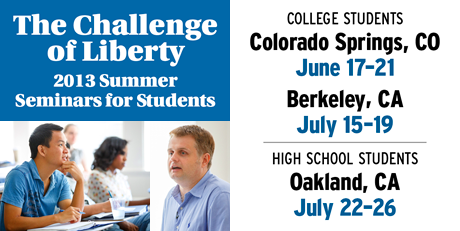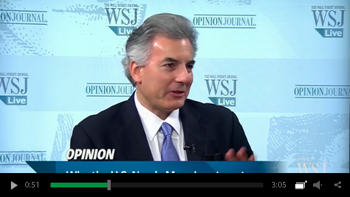The Lighthouse® is the weekly email newsletter of the Independent Institute.
Subscribe now, or browse Back Issues.
Volume 15, Issue 23: June 4, 2013
- Debunking Myths about U.S. Immigration
- The Coming Two-Tiered Healthcare System
- Seeing Past Obama’s Hype about Restricting the War on Terror
- Energy Prices Often Defy Prognosticators and Policymakers
- New Blog Posts
True or False: Immigration rates in the United States are the highest they’ve ever been. False. At 13 percent, the share of foreign-born residents in the U.S. population is one percentage point below the average for the sixty-year span from 1860 to 1920. Let’s try again. True or False: Low-skilled immigrant workers lower the salaries of native-born workers. False, if we’re talking about their impact overall. Although they slightly depress the wages at the lowest end of the pay scale, low-skilled workers help raise wages for others, creating a net increase in wages of 1.8 percent, according to Independent Institute Senior Fellow Alvaro Vargas Llosa, author of Global Crossings: Immigration, Civilization, and America.
“Low-skilled workers fulfill a need by taking jobs others do not want, letting natives move up the scale,” Vargas Llosa writes in an op-ed for Forbes. “Without them employers would need to pay higher salaries, making those products and services more expensive.”
Vargas Llosa’s informative op-ed debunks seven major myths about immigration, including claims about immigrants’ motives, their impact on American culture, and their net contribution to the public purse. Here’s Vargas Llosa’s take on how the country’s economic health makes undocumented immigration self-regulating. “When there is demand for immigrant work, they come in large numbers; in times of recession, the flow stops. Between 2005 and 2010 net immigration came down to zero.... Since the large number of undocumented people implies that legal barriers have not been very effective, it is safe to assume that market forces would be similar in a flexible system. Mexico is progressing and the problem for the U.S. will soon be how to attract more foreign labor!”
Addressing and Discrediting 7 Major Myths about Immigration, by Alvaro Vargas Llosa (Forbes, 5/29/13) Spanish Translation
Video: Alvaro Vargas Llosa on the Immigration Debate (WSJ Opinion Journal, 5/29/13)
Video: Alvaro Vargas Llosa on the Steve Malzberg Show (Newsmax TV, 6/3/13)
Global Crossings: Immigration, Civilization, and America, by Alvaro Vargas Llosa
According to the healthcare consulting firm Merritt Hawkins, a doctor’s office should consider hiring an additional physician if it takes two weeks or longer for it to see a patient. The same firm published a survey in 2009 showing that patients across the United States must wait three weeks on average to see a new doctor. This problem will get worse as the Affordable Care Act goes into effect, according to Independent Institute Research Fellow John C. Goodman. That’s because demand for health services will increase and the supply of doctors available to see patients will fall.
On the demand side, the 32 million newly insured are expected to consume twice as much medical care as they did before Obamacare went into effect. In addition, health insurance plans will be required to cover many more preventive services than before. These two big changes on the demand side of healthcare will be accompanied by two big changes on the supply side: Doctors will retire earlier due to growing frustrations with the bureaucratization of healthcare, and more doctors will leave their private practices in order to work for hospitals, leading them to work fewer hours per week.
“In any other market, that would cause prices to soar,” Goodman writes. “But government plans to control costs (even more so than in the past) by vigorously suppressing provider fees, and the private insurers are likely to resist fee increases as well. That means we are going to have a rationing problem.” Those who can afford to do so will cope with the problem by purchasing concierge service, but this trend will exacerbate the problem for the rest of the population, since doctors who convert their practices to concierge services tend to see only one quarter as many patients as previously. The overall result will be a two-tiered healthcare system, with those in the first tier making those in the second tier wait even longer for care.
Coming Soon to America: A Two-Tiered Canadian-Style Health Care System, by John C. Goodman (Forbes, 5/23/13)
Priceless: Curing the Healthcare Crisis, by John C. Goodman
Obama’s recent speech at the National Defense University signals important tactical changes regarding the use of drones in what used to be called the Global War on Terror—right? Don’t count on it. The new policy restricts the use of drone strikes to targets who pose a “continuing, imminent threat to U.S. persons,” but there are important reasons to believe that it won’t live up to all the hype, Independent Institute Senior Fellow Ivan Eland argues in his latest op-ed.
For one thing, “signature strikes” against unidentified suspected terrorists not covered in the post-9/11 Authorization for the Use of Military Force (AUMF) will still be allowed. In addition, rather than transferring it to the Pentagon, the CIA will keep its drone program after all. Moreover, much of the official Presidential Policy Guidance, a document that spells out the terms and conditions for the use of force in counterterrorism operations, remains classified, thereby ensuring that “the American public is still in the dark about the details of the still illegal and unconstitutional wars its chief executive is running,” Eland writes.
But the strongest basis for skepticism regarding the claims that the Obama administration has reined in the U.S. government’s use of drones is this one: precedent. The White House says that its new standards will restrict the actions of future administrations. In making this claim, the President and his spokespersons seem to have forgotten the lessons of the past. “American history,” Eland continues, “shows that once a precedent for constitutional abuse is set—usually during a crisis—it may lie dormant for years, decades, or even centuries and then be dragged out again.” Thus, for example, Lincoln’s suspension of habeas corpus during the Civil War set the stage for George W. Bush’s habeas suspension nearly a century and a half later. The question therefore isn’t whether a future president will someday unleash constitutional abuses that resemble those of Bush and Obama. The question is: when?
Obama’s New Restricted War on Terror Is Unlikely to Be Lasting, by Ivan Eland (5/30/13)
Recarving Rushmore: Ranking the Presidents on Peace, Prosperity, and Liberty, by Ivan Eland
No War for Oil: U.S. Dependency and the Middle East, by Ivan Eland
Vast fortunes have been made—and lost—from betting on the price of oil. Thirty years ago, Independent Institute Research Fellow S. Fred Singer thought he had it figured out, but the petroleum market looked at his mathematical model...and had a big laugh at his expense. Singer recovered, but the lesson he learned guides him to this day. That lesson is also one that those who make the U.S. government’s energy policies should heed.
Compared to the early 1980s, when Singer was trying to predict energy prices, natural gas plays a far, far greater role. And if present trends continue, it will play an even greater role in the near future. “While natural gas is very cheap in the United States and indeed in many other parts of the world,” Singer writes, “the situation can change drastically because of political decisions that have to do with environmental factors.” For example, the campaign against carbon dioxide has contributed to the adoption of natural gas to help generate electricity. In addition, technological innovations, such as the possibility of converting methane to gasoline, and the discovery of huge natural gas deposits (such as in the Eastern Mediterranean) are also contributing to a new natural-gas economy.
“But political developments can change this benign scenario almost overnight,” Singer continues. “If environmental zealots succeed in curtailing drilling and fracking, gas prices will surely rise and affect oil prices.... Dare we hope that as a ‘lame duck’ Obama will be less likely to follow Green zealots?”
The Oil Price Enigma, by S. Fred Singer (American Thinker, 5/9/13)
Hot Talk, Cold Science: Global Warming’s Unfinished Debate, by S. Fred Singer
From The Beacon:
SCOTUS Upholds Taking of DNA from Arrestee
Melancton Smith (6/3/13)
Replacing Medicare's Ridiculous Fee Schedule
John C. Goodman (6/3/13)
Death and Taxes Now Under One Roof
Mary Theroux (6/2/13)
Why the Precautionary Principle Counsels Us to Renounce Statism
Robert Higgs (6/2/13)
State Power and How It Might Be Undermined
Robert Higgs (6/1/13)
Classical Liberalism’s Impossible Dream
Robert Higgs (5/30/13)
Congressional Criticism of Apple’s Taxes
Randall Holcombe (5/30/13)
Grocery Stores, Healthcare, and the Case for Real Markets
John C. Goodman (5/30/13)
From MyGovCost News & Blog:
Forecasting the Future
Craig Eyermann (6/2/13)
More Stem-Cell Rot
K. Lloyd Billingsley (5/31/13)
The Bureaucrats’ Four-Day Weekend
Craig Eyermann (5/30/13)
Government High-Speed Spending Always
K. Lloyd Billingsley (6/3/13)
You can find the Independent Institute’s Spanish-language website here and blog here.








